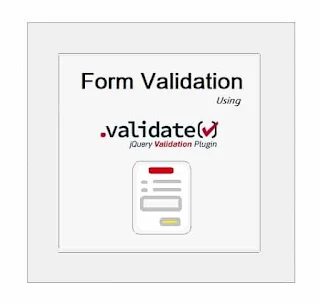Form Validation using jQuery plugin
In this article, you are going to learn how to use a jQuery validate.js plugin to validate HTML form fields.
Before working on form validations, you need to add these files to your program. One is validate.js and the other one is core jQuery core library. In this, we are using only CDN links. If you are working in project, then directly download from here and add to the project.
https://ajax.googleapis.com/ajax/libs/jquery/1.9.1/jquery.min.jshttps://ajax.aspnetcdn.com/ajax/jquery.validate/1.19.3/jquery.validate.min.js Add the above links in a script. Just copy above link and paste in a script tag's src="" attribute.
In this example, just validating name and email. This example gives you how to use plug in and validate form fields.
jQuery's script calling the plugin method validate(). This method taking an array as an argument, which is having two array elements, one is rules and messages.
- rules → defines the rules for form fields, such as require, email, number, min length etc
- messages → defines the messages for each rule. When rule not satisfied, a related message will be displayed.
Validating Name, email
Example:
index.php <html>
<head>
<title>coding-zon jquery form-validation demo </title>
<script src="" ></script>
<script src=""></script>
<script>
$(document).ready(function() {
$("#signupForm").validate({ rules: { name: "required",
email: {
required: true,
email: true,
},
},
messages: { name: "Please enter your first name",
email: "Please enter a valid email address",
}
}); // validate method end
}); //jQuery method end
</script>
</head> <body>
<form action="#" method="post" id="signupForm">
<p> <span>Name :</span>
<input type="text" placeholder="enter your Name" name="name"/></p>
<p> <span>Email :</span>
<input type="text" placeholder="enter your email" name="email"/></p>
<input type="submit" name="submit" value="Submit"/>
</form>
</body>
</html>
Adding CSS
Add the given css any where in <head> section.
<style>
label.error.fail-alert {
background: #fffccc;
color: red;
line-height: 1;
}
input.valid.success-alert {
border: 2px solid #4CAF50;
color: green;
}
</style> Now add CSS elements class in validate() method just before rules. As shown in below code snippet.
<script> $(document).ready(function() { $("#signupForm").validate({ errorClass: "error fail-alert", validClass: "valid success-alert", rules: { name: "required", email: { required: true, email: true, }, }, messages: { name: "Please enter your firstname", email: "Please enter a valid email address", } }); }); </script>
Now the program looks as shown below
Example:
index.php
<html>
<head>
<title>Coding-zon jQuery form-validation demo </title>
<style>
label.error.fail-alert {
background: #fffccc;
color: red;
line-height: 1;
}
input.valid.success-alert {
border: 2px solid #4CAF50;
color: green;
}
</style>
<script src="https://ajax.googleapis.com/ajax/libs/jquery/1.9.1/jquery.min.js" ></script> <script src="https://ajax.aspnetcdn.com/ajax/jquery.validate/1.19.3/jquery.validate.min.js"></script>
<script>
$(document).ready(function() {
$("#signupForm").validate({
errorClass: "error fail-alert",
validClass: "valid success-alert", rules: {
name: "required",
email: {
required: true,
email: true,
},
},
messages: {
name: "Please enter your firstname",
email: "Please enter a valid email address",
}
});
});
</script>
</head>
<body>
<form action="#" method="post" id="signupForm">
<p> <span>Name :</span> <input type="text" placeholder="enter your Name" name="name"/></p>
<p> <span>Email :</span> <input type="text" placeholder="enter your email" name="email"/></p>
<input type="submit" name="submit" value="Submit"/>
</form>
</body> </html>Validating other Form Fields
Example-2:
signup.php
<html>
<head>
<title>Coding-zon jQuery form-validation demo </title>
<script src=""></script>
<script src=""></script>
<script type="text/javascript">
$(document).ready(function() {
// validate signup form on keyup and submit
$("#signupForm").validate({
errorClass: "error fail-alert",
validClass: "valid success-alert",
rules: { name: {
required: true,
minlength: 5,
},
age: {
required: true,
number: true,
min: 18,
},
email: {
required: true,
email: true
},
mobile: {
required: true,
number: true,
minlength: 10,
maxlength: 10,
},
},
messages: {
name: {
required: "Please enter your password",
minlength: "Name should be at least 5 characters",
},
age: {
required: "Please enter your age",
number: "Please enter a numerical value",
min: "You must be at least 18 years old",
},
email: "Please enter a valid email address",
mobile:
{ required: "Please enter a valid mobile no",
minlength: "Enter 10 digits mobile No",
maxlength: "Enter 10 digits mobile No ",
},
},
});
});
</script>
<style>
label.error.fail-alert {
background: #fffccc;
color: red;
line-height: 1;
}
input.valid.success-alert {
border: 2px solid #4CAF50;
color: green;
padding: 2px 0 6px 6px;
}
</style>
</head>
<body>
<form action="#" method="post" id="signupForm">
<p><span>Name :</span>
<input type="text" placeholder="enter your Name" name="name"/></p>
<p><span>Age :</span>
<input type="text" placeholder="enter your age" name="age"/></p>
<p><span>Email :</span>
<input type="text" placeholder="enter your email" name="email"/></p>
<p><span>Phone :</span>
<input type="text" placeholder="Enter 10 digits mobile No" name="mobile" />
</p>
<input type="submit" name="submit" value="Submit"/>
</form>
</body> </html>
<?php if(isset($_POST['submit'])){
$name =$_POST['name'];
$age =$_POST['age'];
$email=$_POST['email'];
$mobile=$_POST['mobile'];
echo "Name".$name."<br />";
echo "age".$age."<br />";
echo "email".$email."<br />";
echo "mobile".$mobile."<br />";
}
?>
To know more about validations visit: this site
Demo
:







Comments
Post a Comment